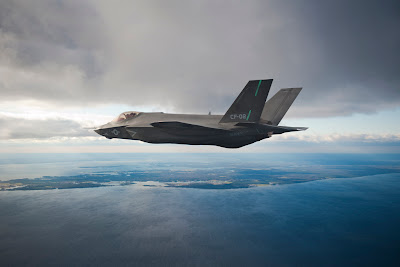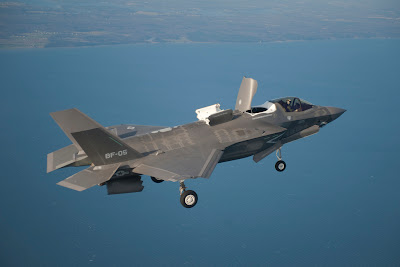Wait...if you can't identify what is obviously an aerial vehicle then by definition it is a UFO!
Monday, December 19, 2011
That's cute. Locals confuse X-47 with a UFO...
Wait...if you can't identify what is obviously an aerial vehicle then by definition it is a UFO!
2nd Recon Bn airborne training...
Pax River welcomes X-47B UCAS
via NAVAIR...
NAVAL AIR SYSTEMS COMMAND, PATUXENT RIVER, Md. – The X-47B Unmanned Combat Air System is scheduled to arrive here tomorrow after completing a yearlong test phase at Edwards Air Force Base, Calif.
Personnel departed Edwards AFB last month with the X-47B loaded on a truck for transport cross-country.
“The transition to Pax River is a highlight for the program,” said Capt. Jaimie Engdahl, Navy UCAS program manager. “We are working toward demonstrating the aircraft’s ability to operate on and around an aircraft carrier.”
The X-47B is a tailless, autonomous, unmanned aircraft that Northrop Grumman is developing and testing for the Navy’s UCAS Demonstration program. X-47B is the first fixed-wing unmanned system designed to operate from a Navy aircraft carrier.
The Navy and Northrop Grumman conducted first flight of the X-47B in February 2011 at Edwards AFB. Since then, the aircraft has undergone a series of flight tests demonstrating its performance under a variety of conditions.
The combined Navy/industry UCAS-D team will conduct shore-based carrier suitability tests at Pax River in 2012. Tests will verify the X-47B's ability to communicate with the aircraft carrier and to operate safely and effectively with the ship's catapult and arresting gear.
Testing at Pax River will be conducted following stringent flight safety procedures and will be conducted within restricted airspace. The first X-47B flight at Pax River is planned for spring 2012. A second X-47B aircraft is also scheduled to arrive early next year.
Sunday, December 18, 2011
ACV competition...what will we likely see...
What will we likely see in the ACV competition to replace the AAV?
More than likely two firms offering vehicles and a few others offering some types of upgrade packages.
I initially see General Dynamics revamping its original EFV offering. Hopefully this will involve the removal of the hydroplanning system...a redesign of the vehicles interior and a decent exit ramp.
I'm actually surprised that the Marine Corps didn't sole source this competition and list what had to go and what needed to stay with this vehicle that had so much money pumped into it. Actually this is probably the best case scenario but won't happen as funds are tight and HQMC seems to be saving all of its money to support the F-35 and MV-22 even at the expense of the much needed CH-53K, AH-1Z, UH-1Y and an upgraded HUMVEE.
The other option is that we see BAE come up with an improved AAV. This would likely involve an upgraded power train and suspension, added armor and blast seats, some type of improved weapon station and upgraded water jets.
What will be interesting is whether HQMC would allow for new build AAVs or if it would be a pure upgrade program. The other players in this game will only offer upgrades of one type or another.
More than likely two firms offering vehicles and a few others offering some types of upgrade packages.
I initially see General Dynamics revamping its original EFV offering. Hopefully this will involve the removal of the hydroplanning system...a redesign of the vehicles interior and a decent exit ramp.
I'm actually surprised that the Marine Corps didn't sole source this competition and list what had to go and what needed to stay with this vehicle that had so much money pumped into it. Actually this is probably the best case scenario but won't happen as funds are tight and HQMC seems to be saving all of its money to support the F-35 and MV-22 even at the expense of the much needed CH-53K, AH-1Z, UH-1Y and an upgraded HUMVEE.
The other option is that we see BAE come up with an improved AAV. This would likely involve an upgraded power train and suspension, added armor and blast seats, some type of improved weapon station and upgraded water jets.
What will be interesting is whether HQMC would allow for new build AAVs or if it would be a pure upgrade program. The other players in this game will only offer upgrades of one type or another.
Saturday, December 17, 2011
Blast from the past. Cruise missile carriers...
Surfing the net I ran across the Cruise Missile Carrier concept from the 70's based on wide body civil airliners.
While the option at the time was between using them or the B-2 in the nuclear deterrence role, the concept is valid in my opinion in the Air-Sea Battle of today.
G-2 mil stated on his blog the following...
B-747s can also dominate the world's oceans. A squadron of 12 B-747s loaded with anti-ship cruise missiles can be vectored toward a enemy fleet by satellites or submarines, while E-3 Sentry AWACS provide escort with long-range radar. The squadron can break into four flights and launch a total of 1064 cruise missiles at a naval fleet from four directions a thousand miles away.While he goes on to make some statements that I disagree with his basic premise seems sound. And valuable for a future war at sea. Taking the nuclear mission out of the equation and you have massive firepower that will have to be protected but could saturate targets at sea and land with cruise missiles outside the range of threat weapon systems.
If we were to develop high speed cruise missiles like our potential enemies then we could in essence have a Chinese carrier killer all in one airplane. Any idea of denying our forces entry into a particular region of the Pacific could be denied with a flight of F-22's with tankers escorting a couple of B-747 cruise missile carriers.
The Air Force would never rethink its thinking on the concept but it is a fascinating blast from the past.
Friday, December 16, 2011
A-4's in the attack...
Neptunus Lex ran an article which details low level flight.
The link he provides is beyond awesome....and the photo you see above is from that link. An Argentinian A-4 attacking British shipping.
Now take another look.
Did you only see the A-4 in the center of the photo?
Or did you notice his wingman to our visual right?
Low level attack in a small airplane. I can't even begin to imagine how small the target must be with a high speed anti-ship cruise missile.
The link he provides is beyond awesome....and the photo you see above is from that link. An Argentinian A-4 attacking British shipping.
Now take another look.
Did you only see the A-4 in the center of the photo?
Or did you notice his wingman to our visual right?
Low level attack in a small airplane. I can't even begin to imagine how small the target must be with a high speed anti-ship cruise missile.
Blast from the past. Para-Marines.
Lets see...we have MARSOC being formed which traces its roots back to the Marine Raider Concept of WW2 so what's missing?
Or perhaps who else should they trace their lineage to?
I contend it would be the Para-Marines.
Although they never performed an Airborne operation in concert with an Amphibious Landing the concept still intrigues. In some ways heliborne ops have negated the need for airborne ops in this regard, but I still wonder if one battalion of Marine Airborne Infantry could be of use in this day and age. I can easily see this battalion that I propose being stationed in Australia and being deployed by Air Force C-17 in ultra rapid deployment situations. Maybe Guam would be a better location? Anyway, read the document below.
Silk Chutes and Hard Fighting US Marine Corps Parachute Units in WWII
Pic of the day...
Program Office and Lockheed make nice.
Still a fan of the F-35 but my antenna is up for spin and manipulation.
I guess the program office and LM are making nice. Why do I say that? Pics released and a vid from NAVAIR that you see above.
I guess the good Admiral is trying to be friendly after telegraphing the report that came out.
CF-2 Flight 41
 |
| U.S. Marine Corp Maj. C.R. Clift flies F-35C test aircraft CF-2 for its 41st flight. (Lockheed Martin photo by Michael D. Jackson) |
 |
| U.S. Marine Corp Maj. C.R. Clift flies F-35C test aircraft CF-2 for its 41st flight. (Lockheed Martin photo by Michael D. Jackson) |
 |
| U.S. Marine Corp Maj. C.R. Clift flies F-35C test aircraft CF-2 for its 41st flight. (Lockheed Martin photo by Michael D. Jackson) |
BF-5
 |
| U.S. Marine Corps Lt. Col. Fred Schenk flies F-35B test aircraft BF-5 in short takeoff/vertical landing (STOVL) mode during the aircraft’s 24th flight. (Lockheed Martin photo by Michael D. Jackson) |
 |
| F-35B test aircraft BF-5 flies in STOVL mode for the first time on Dec. 5, 2011, on its 21st flight. (Lockheed Martin photo by Andy Wolfe) |
Subscribe to:
Posts
(
Atom
)








